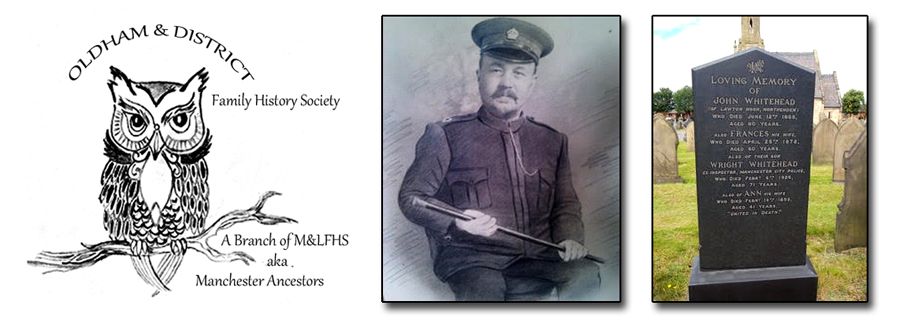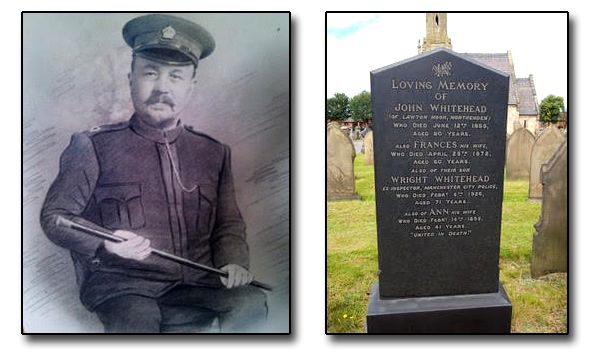
Wright Whitehead –
a case from his career in Manchester Police
From an MLFHS member, Liz Culley (21653), in response to an Oldham & District Branch monthly meeting ...
In your latest Journal, vol.59 no.2 2023, in the feedback given on a talk by Joseph O'Neill on 'Crime City: Manchester's Victorian
Underworld' there is mention of Jerome Caminada and the scuttlers. My 2x gt. grandfather, Wright WHITEHEAD 1854-1926 was a police sergeant in Ancoats in 1892 when the events outlined below took place.
This is a transcript of part of the article published in the ‘Manchester Evening News’ of Friday 20 May 1892 (last column, right-hand side). It concerns the actions of scuttlers (gang members).
My own comments are shown in italics.
MANCHESTER ASSIZES
CROWN COURT – This Day (Before Mr Justice COLLINS)
THE CHARGE OF MURDER AGAINST MANCHESTER SCUTTLERS
William Willan, Edward Fleming, and Charles Davidson, three youths each sixteen years of age, but who appeared rather younger, were indicted for the murder on May 8th, of Peter Kennedy, another lad. (The attack happened in April; Peter died in hospital a couple of weeks later, hence the date 8 May.)
Thomas Kennedy, a hawker, of 58 Haddington Street, Manchester, said the lad Kennedy was his son. He went out about half past five o’clock of the Saturday morning of the day on which he was stabbed, and witness saw him no more until he saw him in the infirmary in the evening.
Wright Whitehead, a sergeant of the Manchester City Police, said he apprehended Willan on April 25th in Great Ancoats Street. He charged him with stabbing Kennedy with a knife, on the 23rd. Willan at first said he hadn’t done it, afterwards he said he got the knife from Fleming. Fleming when arrested said, ‘I hadn’t a knife; I had a stick. The others did as much as we did’. On the 27th witness apprehended Davidson, and charged him with the stabbing which was done in Great Ancoats Street. Davidson made a statement.
……………………………….. (Other details were given here) ……………………………….
James Hands, a lad of sixteen, of Prussia Street, Ancoats, said he worked at the dyeworks at which Kennedy was also engaged. There had been a bother between the Lima Street Gang and the Bradford Street Gang. On Thursday, April 21st, about twenty minutes to six in the evening, he and others met in Alum Street, and Willan, amongst them, asked where Kennedy was.
(Kennedy was not attacked then, nor on the following day. Other witnesses for the prosecution and defence were called regarding who did what prior to and during the event on the Saturday.)
The judge said he thought it was a question for the jury whether the three were assembled for a common purpose in which they knew that there would be a probable use of the knife.
(Character witnesses were called; all maintained that Willan and Fleming were ‘good’ lads.)
All through the address of their counsel the prisoners sobbed loudly.
VERDICT AND SENTENCE
The jury retired at 3.10 to consider their verdict. They returned into court at 4.35 with a verdict of :
GUILTY OF MURDER AGAINST WILLAN
Fleming and Davidson were acquitted. The jury recommended Willan to mercy on account of his youth.
SENTENCE OF DEATH on Willan was passed in the usual form.
Further details following the case :
In fact, Willan was not executed, but sentenced to life imprisonment, although he only served eight years, being released from Strangeways prison in 1900 aged twenty-four. He then worked as a cooper and lived in Harpurhey. In 1905, he married Florence, daughter of Jerome Caminada, the famous Manchester detective! He died aged 75 and was buried at Philips Park Cemetery. Peter Kennedy, his victim, had been interred in the same cemetery.
This was the beginning of the end of the scuttlers. And Wright Whitehead was the police officer who arrested William Willan. (So many alliterative ‘w’s!)

Sgt. (later Inspector) Whitehead and his headstone in Brooklands Cemetery, Sale.
FAMILY
Wright was from a line of John Whiteheads based in Hale and Bowdon. In the Whitehead line, the eldest son would be named John.
1. John Whitehead 1708- was born in Partington and baptised in Bowdon. The family were based in the same area for manygenerations and baptisms, marriages and burials mostly happened at Bowdon. The parish was originally very large, covering an area from the River Mersey to the walls of Tatton Park and fromBaguley to Bollington. Thus it was that John married Elizabeth Moreton there in 1732.
2 Their son John Whitehead 1733-1815 was born in Hale. He married Martha Preston on 12 September 1762 in Northenden, at St Wilfred’s Church, where he had also been baptised. Martha's baptismal record at the same church gives her address as 'Etchels'. Northen Etchells covered the rural area which includes much of modern-day Wythenshawe. As late as 1872, Northen Etchells consisted of farms and clusters of labourers' cottages around Hey Head, Moss Nook, Poundswick, Sharston, Crossacres and Brownlow Green. To the north was Northenden, with Stockport Etchells to the east, Styal to the south, and Baguley and Altrincham to the west.
John and Martha had at least five children. She died in November 1802 and was buried at Bowdon.
Martha Whitehead (Wife of John) burial 10-11-1802
(Record from https://friendsofbowdonchurchyard.org.uk/burials-s-to-z/ )
John was buried aged 82 on 4 October 1815 in Bowdon.
3 John and Martha’s son John was baptised on 25 May 1777. He was not the eldest child: another John had been born in 1764, but died as a baby, so the name was used again. This baptism happened at Ringway but was also registered at Bowdon. John married Betty Brooke in June 1803 and they had at least six children. They lived in a cottage in Hale. Their home was rented from the Egerton family of Tatton Hall. The 1839 tithe record shows that they had a total of 3 roods and 21 perches in land, so nearly 1 acre. Betty died in June 1849 and two years later records show John as a ‘wood man’, a widower living with his son William, a shoemaker, and William’s wife Hannah.
A wood man, or wood ranger, would have been employed in the maintenance and protection of woodlands. John was in his 70s, but still working. He passed away in October 1857, aged 80.
4 The next John Whitehead was also long-lived (1804-85). He was baptised at the Presbyterian Chapel, Shaws Lane, in Hale. His future wife, Frances Singleton, was from Blackrod in Lancashire. She was born in 1811, the child of Margaret Singleton. Her father was not named on her baptism record. She married John Whitehead on 20 April 1835, in Manchester Cathedral, the 'old church', in a batch wedding. Fifty-five other couples were married there that day! Frances marked X as signature on her marriage record. John, who signed the register, gave his profession as farmer but in 1841 when they were living in Bowdon, he was an agricultural labourer. His stated occupation alternated between the two over the years. They lived at Clay House and later at Lawton Moor.
They had 5 children :
William, who moved to Manchester in the 1860s, married Ann Willan (no relation to the William Willan arrested in 1892, as far as I have been able to ascertain) and had 2 children. He later moved to Canada, leaving his family behind.
Elizabeth, who never married, but had a son named John William Whitehead (born 1878) who later went to sea and died of cholera as a young man. Her brother Wright was so scandalized (!!) by Elizabeth’s behaviour that he refused to speak to her ever again.
Sarah, who married Albert Williams, had 3 children and moved to Gloucestershire, then to Cardiff, running a hardware shop.
WRIGHT (my 2x great-grandfather) who started as a farm worker, then joined the City of Manchester Police Force, rising to Inspector. His father came to live with Wright's family in Ardwick in the 1880s.
John, who also moved to Manchester after initially working in farming. He became a carter.
Wright and John married sisters Ann and Jane Bramhall, who both worked as housemaids before they married.
5 WRIGHT Whitehead was born in July 1854 in Hale, Cheshire. At the age of 10 he started work as a farm hand, later training as a ploughboy at nearby Wythenshawe Hall. According to an article in 'The Police Review and Parade Gossip' of 12 May 1911, which commemorated his retirement the previous December, he entered the service of Mr Thomas W. Tatton, where 'farming was conducted on scientific principles'. He was advised by the village constable to apply to Manchester City Police, which he did, joining on 13 November 1873. He was first attached to C Division and was stationed in the Ancoats district for twelve years. At that time, according to the same article, '... every class of crime prevailed in the district, the place being overrun with scuttlers. It was no unusual thing for battles to be fought, from fifty to one hundred persons being engaged on either side. Every kind of weapon was brought into play, from knives to revolvers.' This is where the events of 1892 brought Sergeant Whitehead to prominence. He later took a brave stand against corruption among magistrates.
Wright rose to the rank of inspector. His wife Ann died at 41, and his daughters took over raising his youngest sons. He died in 1926 and was so proud of being a police officer that his profession is stated on his headstone. When asked about his children, he often said that he had 3 sons (he actually had 5) because only the ones in the police force really counted. He and Ann had 8 children altogether, the eldest of whom was John, my great-grandfather, who was thrown out of the family home when he was 17. He never spoke to his father again (this is a recurring theme in Wright’s life) and did not attend his funeral. Another child, John’s sister Hannah, incurred Wright’s wrath by eloping to marry; this estrangement was ultimately resolved.
P.S. My cousin twice removed, a venerable lady, donated items regarding Wright's career to the Police Museum in Manchester in 1996.
Many thanks to Liz for sharing this story with us.
Return to :
* Pictorial Index of articles etc.